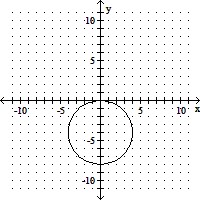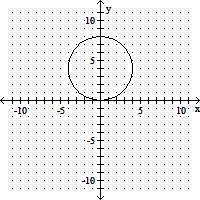The following table shows the velocity V, in meters per second, of a rock t seconds after it is thrown downward on the planet Mercury.
t 0 1 2 3 V 17 20.61 24.22 27.83?
A: Complete a table of changes to show that the data are linear. Round your answer to two decimal places, if necessary.B: Find a linear model for the data. Round your answer to two decimal places, if necessary.C: Explain in practical terms the meaning of the slope of the linear function you found in part B. Round your answer to two decimal places, if necessary.
What will be an ideal response?
| Change in t | From 0 to 1 | From 1 to 2 | From 2 to 3 |
| Change in V | 3.61 | 3.61 | 3.61 |
?
B:
C: For each second that passes, the velocity increases by 3.61 meters per second. Therefore, the acceleration due to gravity on Mercury is 3.61 meters per second per second.
You might also like to view...
Graph the circle.x2 + (y - 4)2 = 16
A. 
B. 
C. 
D. 
Solve the problem. Round to the nearest cent.On June 1, the unpaid balance in an account was $162. On June 12, a payment of $60 was made. The interest rate per month was 1.5% per month of the average daily balance. Find the new balance at the end of June.
A. $103.86 B. $120.60 C. $103.81 D. $103.50
Solve the exponential equation.64 = 45x ? 16x2
A. -3 , 
B. -3 , -4
C. 3 , - 
D. 3 , 4
Use the Intermediate Value Theorem to determine whether the polynomial function has a zero in the given interval.f(x) = 2x3 - 4x - 9; [2, 3]
A. f(2) = -1 and f(3) = 33; yes B. f(2) = 1 and f(3) = -33; yes C. f(2) = 1 and f(3) = 33; no D. f(2) = -1 and f(3) = -33; no
